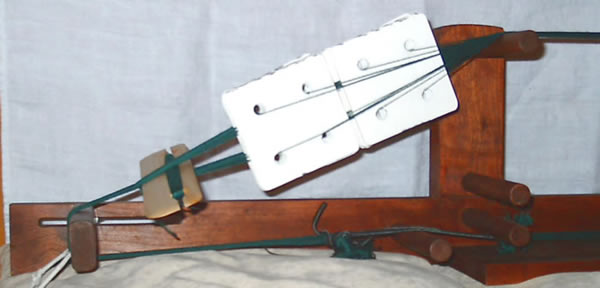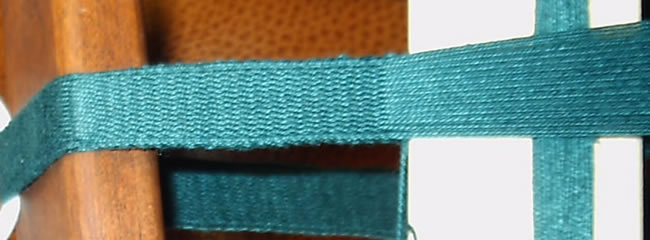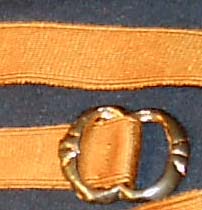 Museum of London, Braid 423
Museum of London, Braid 423
Research:
Tablet weaving has been used to create narrow wares all throughout the time period we study. Wooden, antler and leather tablets of 4 or more holes have been discovered in ancient digs in Denmark and London. The Museum of London analyzes several braids in their book Textiles and Clothing c. 1150-c. 1450. One of these, labeled Braid 423, is a fragment found attached to a bronze belt tip. [Crowfoot p.133] The picture in Textiles and Clothing shows the simulated satin effect with three hole possible for rivets. The original is made of silk for a girdle or belt, and has been dated to the early fifteenth century. Mistress Thora Sharptooth (Carolyn Priest-Dorman) charted out this and other patterns in her article Three Recipes for Fourteenth- and Fifteenth-Century Tablet Weaving. c. 1995. The pattern is 28 cards wide, but easily scalable by adding or subtracting cards in packs of two. In this pattern 20 of these cards produce the satin effect, with each selvedge being 4 cards wide.
Process:
I decided to use a size 10 mercerized crochet cotton thread in dark green for my recreation of this braid. It was easily obtainable at a local craft store (JoAnn's Etc.), produced a reasonably smooth band, as well as being inexpensive. Since this was essentially my fourth attempt at tablet weaving, I chose to compromise for those reasons and work with the cotton.
I threaded 28 cards all S, and then flipped every other card to get the threading sequence of alternating S and Z. I followed Thora's pattern (included below) except that I only used two cards for the selvedges on each edge, and made the body of the satin 24 cards wide. This was honestly a mistake in starting the pattern, and to keep continuity in the piece, I did not correct it midway through. The resulting band is 3/4 inch wide and approximately 37 inches long. This project was warped on my Inkle loom on March 28, 2003-completed June 8, 2003.
Due to the twisted nature of the threads in tablet weaving, almost any pattern that requires you to turn one direction, will need to be reversed periodically to undo some of that twist. You will find several parts of the pattern where a reverse is evident. These reverses have been found in period examples as well, and is a necessary part of weaving. I've tried to space out the reverses evenly.

Pattern courtesy of Mistress Thora Sharptooth
Pack 1 consists of the 4 edge cards, 2 on either side. Pack 2 is the remaining odd cards, and Pack 3 is the remaining even cards. This makes it easily scalable by adding more cards in groups of 2. You turn the selvedges each time all in one direction, and you alternate turning Packs 2 and 3 each turn. 8 turns of the selvedge cards equals 4 complete turns of Packs 2 and 3. If you color code your cards this is fairly easy to follow.

You can see the project in progress here warped on my inkle loom.

Here you can see a close up view of the work in progress. Can you see the satin effect that it produces? Essentially every strand in the satin part of the band floats once, but by alternating the cards it spreads out to form a satin. This is the same pattern Bera followed for the belt she made for me. Only she used a very fine silk, and used 50 cards.
Bera Thorbjornsdottir's version of the simulated satin
worked in silk, 50 cards wide.
Bibliography:
Priest-Dorman, Carolyn. Three Recipes for Fourteenth- and Fifteenth-Century Tablet Weaving. c. 1995. <http://www.cs.vassar.edu/~capriest/3recipes.html>
Crowfoot, Elisabeth; Pritchard, Frances; and Staniland, Kay. Textiles and Clothing c. 1150-c. 1450. Medieval Finds from Excavations in London, 4. London: HMSO, 1992.